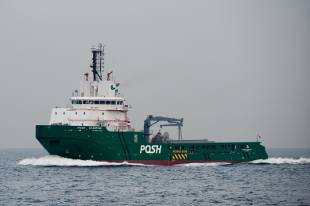
The ABS classed “Posh Champion” is an example of the growing sophistication in this vessel type featuring high horsepower and strong bollard pull rating, dynamic position system (DPS-2) with a rail mounted crane which can move fore and aft to service the workdeck. The class notation for this unit is A1, Towing Vessel, Fire Fighting Vessel Class 1, Offshore Support Vessel AH, , AMS, ACCU, DPS-2, ES2020 . (Photo courtesy of POSH Semco Pte Ltd.)
Increased sophistication within the offshore support vessel (OSV) market has prompted classification society ABS to develop standalone guidance for these more specialized yet multi-functional vessels. Newly developed criteria and relevant existing Rule requirements have been consolidated into the ABS Guide for Building and Classing Offshore Support Vessels.
ABS classes approximately one-third of the worldwide OSV fleet and in the past had reviewed these specialized vessels by following the ABS Rules for Building and Classing Steel Vessels Under 90 Meters (295 Feet) in Length. The new OSV Guide will be applicable to OSVs of all sizes and it includes specific guidance for the various segments of the global support vessel market.
“Today’s support vessels are a far cry from previous designs sharing the same name,” said Mike Sano who leads the society’s OSV Market Sector Group. “As the search for oil and gas moves into deeper waters, along with increased activity in the renewable offshore energy market, more specialized and technically advanced types of OSVs are needed for various support roles.”
ABS engineers are reviewing plans for some of the most technically advanced OSVs being proposed. The recent specialized multipurpose designed vessels carry out maintenance and repairs on platforms, facilities and subsea piping, equipment and systems. The new requirements from ABS are tailored for these new generation vessels.
“The Guide takes a comprehensive approach toward OSV design,” said Wei Huang, ABS Manager, Offshore Technology and principal author of the Guide. “New categories of offshore service types such as well intervention and oil spill recovery vessels are included along with updates for advances in specialized equipment.”
The OSV Guide consists of four major sections: scope and conditions of classification; hull construction and equipment; machinery and systems; and offshore support services. Material and welding, strengthening for navigation in ice, and survey during and after construction are referenced from the ABS Rules for Building and Classing Steel Vessels. The intent is to evolve the ABS Guide for Building and Classing Offshore Support Vessels into Rules during the society’s next Rule making cycle.
Included in the OSV Guide are explanations of notations reflecting specialized capabilities such as transportation of supplies and equipment, towing and anchoring of offshore structures, fire fighting, diving, oil spill recovery, safety standby rescue, pipe laying, handling heavy surface and subsea loads, well intervention, well stimulation, well test and wind farm support.















